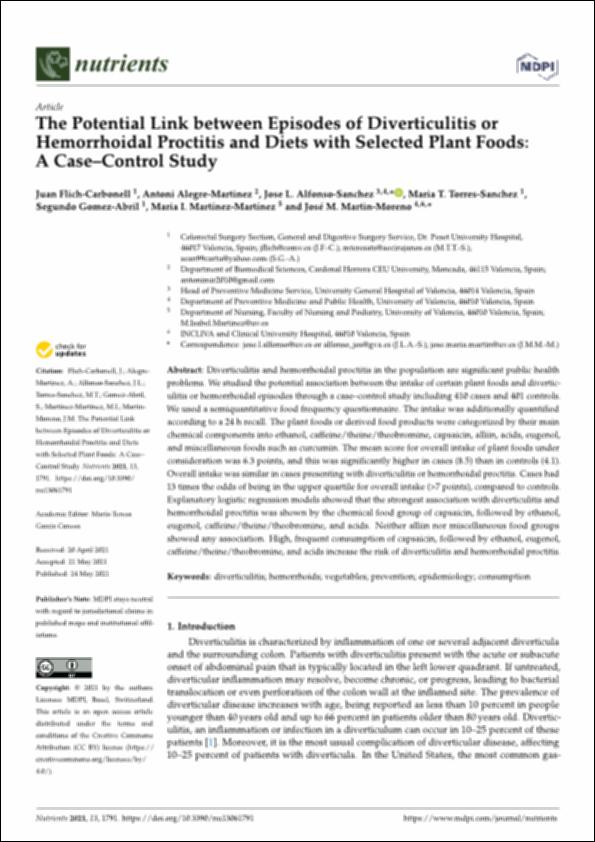Please use this identifier to cite or link to this item:
http://hdl.handle.net/10637/12902The potential link between episodes of diverticulitis or hemorrhoidal proctitis and diets with selected plant foods : a case-control study
| Title: | The potential link between episodes of diverticulitis or hemorrhoidal proctitis and diets with selected plant foods : a case-control study |
| Authors : | Flich Carbonell, Juan Alegre Martínez, Antoni Alfonso Sánchez, José L. Torres Sánchez, María Teresa Gómez Abril, Segundo Martínez Martínez, María Isabel Martín Moreno, José María |
| Keywords: | Enfermedades carenciales - Factores de riesgo.; Diverticulitis - Factores de riesgo.; Diverticulitis - Risk factors.; Hemorroides - Factores de riesgo.; Hemorrhoids - Risk factors.; Vegetables consumption - Risk factors.; Nutrición - Trastornos.; Nutrition disorders.; Deficiency diseases - Risk factors.; Hortalizas - Consumo - Factores de riesgo. |
| Publisher: | MDPI |
| Citation: | Flich-Carbonell, J., Alegre-Martinez, A., Alfonso-Sánchez, J.L., Torres-Sánchez, M.T., Gomez-Abril, S., Martínez-Martínez, M.I. et al. (2021). The potential link between episodes of diverticulitis or hemorrhoidal proctitis and diets with selected plant foods: a case–control study. Nutrients, vol. 13, i. 6 (24 may.), art. 1791. DOI: https://doi.org/10.3390/nu13061791 |
| Abstract: | Diverticulitis and hemorrhoidal proctitis in the population are significant public health problems. We studied the potential association between the intake of certain plant foods and diverticulitis or hemorrhoidal episodes through a case–control study including 410 cases and 401 controls. We used a semiquantitative food frequency questionnaire. The intake was additionally quantified according to a 24 h recall. The plant foods or derived food products were categorized by their main chemical components into ethanol, caffeine/theine/theobromine, capsaicin, alliin, acids, eugenol, and miscellaneous foods such as curcumin. The mean score for overall intake of plant foods under consideration was 6.3 points, and this was significantly higher in cases (8.5) than in controls (4.1). Overall intake was similar in cases presenting with diverticulitis or hemorrhoidal proctitis. Cases had 13 times the odds of being in the upper quartile for overall intake (>7 points), compared to controls. Explanatory logistic regression models showed that the strongest association with diverticulitis and hemorrhoidal proctitis was shown by the chemical food group of capsaicin, followed by ethanol, eugenol, caffeine/theine/theobromine, and acids. Neither alliin nor miscellaneous food groups showed any association. High, frequent consumption of capsaicin, followed by ethanol, eugenol, caffeine/theine/theobromine, and acids increase the risk of diverticulitis and hemorrhoidal proctitis. |
| Description: | Este artículo se encuentra disponible en la siguiente URL: https://www.mdpi.com/2072-6643/13/6/1791 Este artículo pertenece a la sección "Clinical nutrition)". |
| URI: | http://hdl.handle.net/10637/12902 |
| Rights : | http://creativecommons.org/licenses/by/4.0/deed.es |
| ISSN: | 2072-6643 (Electrónico). |
| Issue Date: | 24-May-2021 |
| Center : | Universidad Cardenal Herrera-CEU |
| Appears in Collections: | Dpto. Ciencias Biomédicas |
Items in DSpace are protected by copyright, with all rights reserved, unless otherwise indicated.


